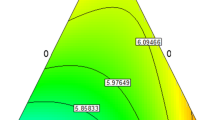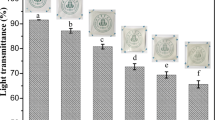Abstract
Here, edible films were prepared by using levan biopolymer and different proportions of powdered ostrich eggshell. These films were characterized, and their bioactivity was measured. Adding ostrich eggshells to the levan films made the film surface smoother. Ostrich eggshell added to the films reduced the water vapor permeability in the films. Levan biopolymer film and ostrich eggshell showed high antioxidant activity when used together (%83.03). The ERL sample without ostrich eggshell has an antimicrobial effect only on bacteria. The highest antimicrobial effect was measured on Pseudomonas aeruginosa with the film sample EROL-6 containing 1.2 g of ostrich eggshell. ERL film samples inhibited the biofilm of Pseudomonas aeruginosa by 68.6%. This is the first study using ostrich eggshells to produce edible film.









Similar content being viewed by others
Data availability
Patient-related data not included in the paper might be subject to patient confidentiality. All other data are available from the authors upon reasonable request.
References
Yoo SH, Yoon EJ, Cha J, Lee HG (2004) Antitumor activity of levan polysaccharides from selected microorganisms. Int J Biol Macromol. https://doi.org/10.1016/j.ijbiomac.2004.01.002
Matsuhira H, Tamura KI, Tamagake H et al (2014) High production of plant type levan in sugar beet transformed with timothy (Phleum pratense) 6-SFT genes. J Biotechnol. https://doi.org/10.1016/j.jbiotec.2014.09.025
Koşarsoy Ağçeli G, Cihangir N (2020) Nano-sized biopolymer levan: its antimicrobial, anti-biofilm and anti-cancer effects. Carbohydr Res. https://doi.org/10.1016/j.carres.2020.108068
Aramsangtienchai P, Kongmon T, Pechroj S, Srisook K (2020) Enhanced production and immunomodulatory activity of levan from the acetic acid bacterium, Tanticharoenia sakaeratensis. Int J Biol Macromol. https://doi.org/10.1016/j.ijbiomac.2020.07.001
Srikanth R, Siddartha G, Sundhar Reddy CHSS et al (2015) Antioxidant and anti-inflammatory levan produced from Acetobacter xylinum NCIM2526 and its statistical optimization. Carbohydr Polym. https://doi.org/10.1016/j.carbpol.2014.12.079
Öner ET, Hernández L, Combie J (2016) Review of Levan polysaccharide: from a century of past experiences to future prospects. Biotechnol Adv 34:827–844
Srikanth R, Reddy CHSSS, Siddartha G et al (2015) Review on production, characterization and applications of microbial levan. Carbohydr Polym. https://doi.org/10.1016/j.carbpol.2014.12.003
Koşarsoy Ağçeli G, Hammamchi H, Cihangir N (2021) Novel levan/bentonite/essential oil films: characterization and antimicrobial activity. J Food Sci Technol. https://doi.org/10.1007/s13197-021-05009-4
Cooper RG (2000) Critical factors in ostrich (Struthio camelus australis) production: a focus on southern Africa. Worlds Poult Sci J. https://doi.org/10.1079/wps20000019
Al-Nasser A, Al-Khalaifa H, Holleman K, Al-Ghalaf W (2003) Ostrich production in the arid environment of Kuwait. J Arid Environ. https://doi.org/10.1006/jare.2001.0876
Gautron J, Bain M, Solomon S, Nys Y (1996) Soluble matrix of hen’s eggshell extracts changes in vitro the rate of calcium carbonate precipitation and crystal morphology. Br Poult Sci. https://doi.org/10.1080/00071669608417914
Ferreira JRM, Louro LHL, Costa AM et al (2016) Ostrich eggshell as calcium source for the synthesis of hydroxyapatite and hydroxyapatite partially substituted with zinc. Ceramica. https://doi.org/10.1590/0366-69132016623642002
Dupoirieux L (1999) Ostrich eggshell as a bone substitute: a preliminary report of its biological behaviour in animals–a possibility in facial reconstructive surgery. Br J Oral Maxillofac Surg. https://doi.org/10.1054/bjom.1999.0041
Faridi H, Arabhosseini A (2018) Application of eggshell wastes as valuable and utilizable products: a review. Res Agric Eng. https://doi.org/10.17221/6/2017-RAE
Rezaei R, Mohadesi M, Moradi GR (2013) Optimization of biodiesel production using waste mussel shell catalyst. Fuel. https://doi.org/10.1016/j.fuel.2013.03.004
Martin-Luengo MA, Yates M, Ramos M et al (2011) Biomaterials from beer manufacture waste for bone growth scaffolds. Green Chem Lett Rev. https://doi.org/10.1080/17518253.2010.544331
Murakami FS, Rodrigues PO, De Campos CMT, Silva MAS (2007) Physicochemical study of CaCO3 from egg shells. Cienc e Tecnol Aliment. https://doi.org/10.1590/S0101-20612007000300035
Kam S-K, Hyun S-S, Lee M-G (2011) Removal of divalent heavy metal ions by Na-P1 synthesized from Jeju scoria. J Environ Sci. https://doi.org/10.5322/jes.2011.20.10.1337
Ss K, Indumathi MP, Rajarajeswari GR (2019) Mahua oil-based polyurethane/chitosan/nano ZnO composite films for biodegradable food packaging applications. Int J Biol Macromol. https://doi.org/10.1016/j.ijbiomac.2018.11.195
ASTM Committee D06, ASTM D644–99 (2002) Standard test method for moisture content of paper and paperboard by oven drying. American National Standard
Lee JH, Jeong D, Kanmani P (2019) Study on physical and mechanical properties of the biopolymer/silver based active nanocomposite films with antimicrobial activity. Carbohydr Polym. https://doi.org/10.1016/j.carbpol.2019.115159
Zhang W, Chen J, Chen Y et al (2016) Enhanced physicochemical properties of chitosan/whey protein isolate composite film by sodium laurate-modified TiO2 nanoparticles. Carbohydr Polym. https://doi.org/10.1016/j.carbpol.2015.11.031
Giteru SG, Coorey R, Bertolatti D et al (2015) Physicochemical and antimicrobial properties of citral and quercetin incorporated kafirin-based bioactive films. Food Chem. https://doi.org/10.1016/j.foodchem.2014.07.077
Wang C, Chang T, Dong S et al (2020) Biopolymer films based on chitosan/potato protein/linseed oil/ZnO NPs to maintain the storage quality of raw meat. Food Chem. https://doi.org/10.1016/j.foodchem.2020.127375
Maryam Adilah ZA, Jamilah B, Nur Hanani ZA (2018) Functional and antioxidant properties of protein-based films incorporated with mango kernel extract for active packaging. Food Hydrocoll. https://doi.org/10.1016/j.foodhyd.2017.08.017
Siripatrawan U, Harte BR (2010) Physical properties and antioxidant activity of an active film from chitosan incorporated with green tea extract. Food Hydrocoll. https://doi.org/10.1016/j.foodhyd.2010.04.003
Kumari M, Mahajan H, Joshi R, Gupta M (2017) Development and structural characterization of edible films for improving fruit quality. Food Packag Shelf Life. https://doi.org/10.1016/j.fpsl.2017.02.003
Valgas C, De Souza SM, Smânia EFA, Smânia A (2007) Screening methods to determine antibacterial activity of natural products. Brazilian J Microbiol. https://doi.org/10.1590/S1517-83822007000200034
O’Toole GA (2010) Microtiter dish biofilm formation assay. J Vis Exp. https://doi.org/10.3791/2437
Feng QL, Zhu X, Li HD, Kim TN (2001) Crystal orientation regulation in ostrich eggshells. J Cryst Growth. https://doi.org/10.1016/S0022-0248(01)01611-6
Texier PJ, Porraz G, Parkington J et al (2010) A howiesons poort tradition of engraving ostrich eggshell containers dated to 60,000 years ago at Diepkloof rock shelter, South Africa. Proc Natl Acad Sci USA. https://doi.org/10.1073/pnas.0913047107
Chen X, Gao H, Ploehn HJ (2014) Montmorillonite-levan nanocomposites with improved thermal and mechanical properties. Carbohydr Polym 101:565–573. https://doi.org/10.1016/j.carbpol.2013.09.073
Mantovan J, Bersaneti GT, Faria-Tischer PCS et al (2018) Use of microbial levan in edible films based on cassava starch. Food Packag Shelf Life. https://doi.org/10.1016/j.fpsl.2018.08.003
Portugal S, Maurer G, Cassey P (2010) Eggshell permeability: a standard technique for determining interspecific rates of water vapor conductance. Physiol Biochem Zool. https://doi.org/10.1086/656287
Nys Y, Gautron J, Garcia-Ruiz JM, Hincke MT (2004) Avian eggshell mineralization: biochemical and functional characterization of matrix proteins. Comptes Rendus–Palevol. https://doi.org/10.1016/j.crpv.2004.08.002
Mikšík I, Eckhardt A, Sedláková P, Mikulikova K (2007) Proteins of insoluble matrix of avian (Gallus Gallus) eggshell. Connect Tissue Res. https://doi.org/10.1080/03008200601003116
Gorchein A, Lim CK, Cassey P (2009) Extraction and analysis of colourful eggshell pigments using HPLC and HPLC/electrospray ionization tandem mass spectrometry. Biomed Chromatogr. https://doi.org/10.1002/bmc.1158
Romano N, Santos M, Mobili P et al (2016) Effect of sucrose concentration on the composition of enzymatically synthesized short-chain fructo-oligosaccharides as determined by FTIR and multivariate analysis. Food Chem. https://doi.org/10.1016/j.foodchem.2016.02.002
Santos MI, Araujo-Andrade C, Tymczyszyn EE, Gómez-Zavaglia A (2014) Determination of amorphous/rubbery states in freeze-dried prebiotic sugars using a combined approach of near-infrared spectroscopy and multivariate analysis. Food Res Int. https://doi.org/10.1016/j.foodres.2014.07.040
Brown CR, Peinke D, Loveridge A (1996) Mortality in near-term ostrich embryos during artificial incubation. Br Poult Sci. https://doi.org/10.1080/00071669608417838
Horrocks NPC, Hegemann A, Matson KD et al (2012) Immune indexes of larks from desert and temperate regions show weak associations with life history but stronger links to environmental variation in microbial abundance. Physiol Biochem Zool. https://doi.org/10.1086/666988
Horrocks NPC, Hine K, Hegemann A et al (2014) Are antimicrobial defences in bird eggs related to climatic conditions associated with risk of trans-shell microbial infection? Front Zool. https://doi.org/10.1186/1742-9994-11-49
Chen X, Li X, He Z et al (2019) Comparative study of eggshell antibacterial effectivity in precocial and altricial birds using Escherichia coli. PLoS One. https://doi.org/10.1371/journal.pone.0220054
Author information
Authors and Affiliations
Contributions
Gözde Koşarsoy Ağçeli contributed to investigation, resources, writing—original draft.
Corresponding author
Ethics declarations
Conflict of interest
All authors declare that there is no conflict of interest.
Ethical approval
This article does not contain any studies with human participants or animals performed by any of the authors.
Additional information
Publisher's Note
Springer Nature remains neutral with regard to jurisdictional claims in published maps and institutional affiliations.
Rights and permissions
About this article
Cite this article
Koşarsoy Ağçeli, G. Development of ostrich eggshell and nano-levan-based edible biopolymer composite films: characterization and bioactivity. Polym. Bull. 79, 11201–11215 (2022). https://doi.org/10.1007/s00289-021-04069-y
Received:
Revised:
Accepted:
Published:
Issue Date:
DOI: https://doi.org/10.1007/s00289-021-04069-y




